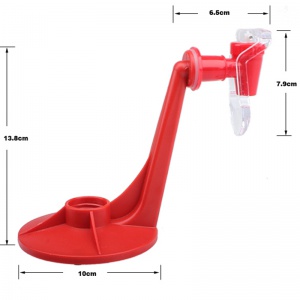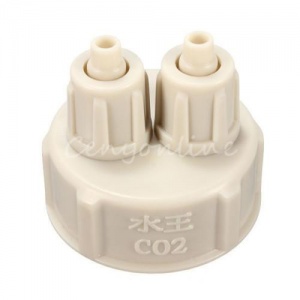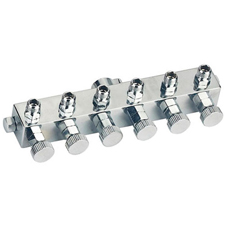Difference between revisions of "BarBot/Components/Pressurised Mixer Dispenser"
(Create page with mossing info and some TODO placeholders) |
m (Danspencer101 moved page Project:BarBot/Components/Pressurised Mixer Dispenser to BarBot/Components/Pressurised Mixer Dispenser) |
||
| (6 intermediate revisions by one other user not shown) | |||
| Line 2: | Line 2: | ||
===General Description=== | ===General Description=== | ||
| − | The pressurised mixer dispenser pours carbonated and other mixer drinks using a servo-driven tap backed by a pressurised system which uses compressed CO2 to | + | The pressurised mixer dispenser pours carbonated and other mixer drinks using a servo-driven tap backed by a pressurised system which uses compressed CO2 to siphon drinks out of standard PET carbonated drinks bottles. |
| + | |||
| + | The dispensing end is based on this inexpensive fizzy drinks tap that is quite popular on eBay | ||
| + | |||
| + | [[File:Barbot poptap1.jpg|none|300px|Red Pop Tap]] | ||
| + | |||
| + | In normal intended use this tap screws directly onto the bottle, the whole thing is inverted to stand on the base and the user just pushes their glass against the clear plastic tab to dispense. This works great when the bottle is first opened and there is plenty of fizz but it soon becomes necessary to squeeze the bottle to dispense the drink. This limitation seems to be well understood to the extent that most eBay sellers show a picture of the user squeezing the bottle! So it's mostly a novelty item but it does have a fully functional and tap that would otherwise cost significantly more than the cost of the whole item! | ||
| + | |||
| + | A number of options are available to maintain consistent pressure to make this work - the one chosen is to provide a low-pressure head of CO2 that will replace the dispensed drink and stop the drink from going flat. Rather than modify each bottle to provide a port for the incoming CO2, a special two-port cap is used. | ||
| + | |||
| + | [[File:Barbot co2cap1.jpg|none|300px|CO2 Pop Cap]] | ||
| + | |||
| + | Each port accepts a connection from 6mm OD, 4mm ID tubing on the inside and outside. One of the ports is for incoming pressurised CO2 and the other is for the siphon out of carbonated beverage. Both connections will accept the "standard" food-safe flexible 6mm silicone tubing that we have been using. The fizzy drink bottles can now stand upright with a siphon tube from the cap output port down to the bottom of the bottle. The output tube needs to be connected to the pop tap and here we make use of the standard bottle screw thread feature of the pop taps: the neck of a PET bottle is used as an adapter - a snug fitting cork with a hole drilled through it allows connection to the 6mm silicone tubing. | ||
| + | |||
| + | [[File:Barbot tap-adapter1.jpg|none|300px|Tap Adapter]] | ||
| + | |||
| + | (TODO: manifold notes) | ||
| + | [[File:Barbot manifold1.jpg|none|228px|6-way manifold]] | ||
| + | |||
| + | (TODO: CO2 bottle notes - high and low pressure) | ||
| + | |||
| + | (TODO: servo control notes) | ||
| + | |||
| + | (TODO: general usage - bottle changeover maintenance, etc.) | ||
===Mounting & hardware=== | ===Mounting & hardware=== | ||
| − | * Red | + | * Red pop dispenser taps |
| + | ** | ||
* TODO: add mounting hardware, tubing, corks and such | * TODO: add mounting hardware, tubing, corks and such | ||
Latest revision as of 11:49, 5 February 2019
Pressurised Mixer Dispenser
General Description
The pressurised mixer dispenser pours carbonated and other mixer drinks using a servo-driven tap backed by a pressurised system which uses compressed CO2 to siphon drinks out of standard PET carbonated drinks bottles.
The dispensing end is based on this inexpensive fizzy drinks tap that is quite popular on eBay
In normal intended use this tap screws directly onto the bottle, the whole thing is inverted to stand on the base and the user just pushes their glass against the clear plastic tab to dispense. This works great when the bottle is first opened and there is plenty of fizz but it soon becomes necessary to squeeze the bottle to dispense the drink. This limitation seems to be well understood to the extent that most eBay sellers show a picture of the user squeezing the bottle! So it's mostly a novelty item but it does have a fully functional and tap that would otherwise cost significantly more than the cost of the whole item!
A number of options are available to maintain consistent pressure to make this work - the one chosen is to provide a low-pressure head of CO2 that will replace the dispensed drink and stop the drink from going flat. Rather than modify each bottle to provide a port for the incoming CO2, a special two-port cap is used.
Each port accepts a connection from 6mm OD, 4mm ID tubing on the inside and outside. One of the ports is for incoming pressurised CO2 and the other is for the siphon out of carbonated beverage. Both connections will accept the "standard" food-safe flexible 6mm silicone tubing that we have been using. The fizzy drink bottles can now stand upright with a siphon tube from the cap output port down to the bottom of the bottle. The output tube needs to be connected to the pop tap and here we make use of the standard bottle screw thread feature of the pop taps: the neck of a PET bottle is used as an adapter - a snug fitting cork with a hole drilled through it allows connection to the 6mm silicone tubing.
(TODO: manifold notes)
(TODO: CO2 bottle notes - high and low pressure)
(TODO: servo control notes)
(TODO: general usage - bottle changeover maintenance, etc.)
Mounting & hardware
- Red pop dispenser taps
- TODO: add mounting hardware, tubing, corks and such
Logical
- [boot]Sends message: "ready <dispenser-id>"
- Receives message: "dispense <t-seconds>".
- Uses servo to open tap
- Pause for t-seconds
- Returns servo to closed value position
- Sends message: "done <dispenser-id>"
- Sends message: "ready <dispenser-id>"
Connections
TODO
Power
TODO
Bling
TODO


